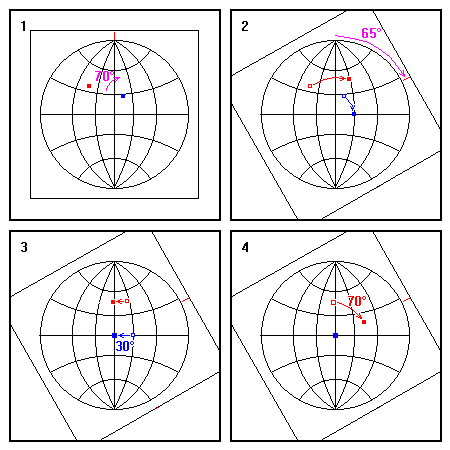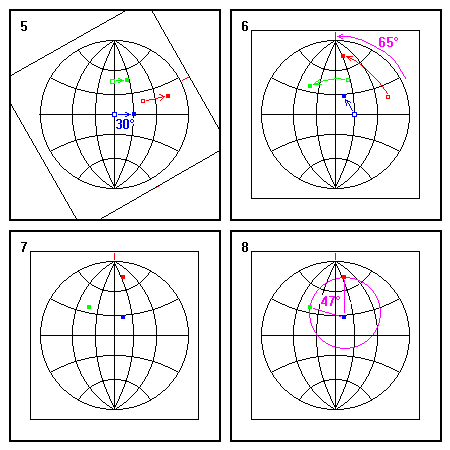Rotate Points Around an Arbitrary Axis
(Vertical Axis Method)
Steven Dutch, Professor Emeritus, Natural and Applied Sciences, University of Wisconsin - Green Bay
Rotations around an arbitrary axis are about the most complex stereonet constructions. They arise particularly when data from folded or tilted rocks must be restored to their original orientations when the rocks were horizontal. Current directions and magnetic pole orientations are examples. Multiple rotations also arise in universal-stage research in petrology.
The general sequence of steps necessary is as follows:
- Plot the data and the rotation axis.
- Rotate the rotation axis to a location where the data can be rotated on a stereonet. This means rotating the axis to either a vertical or horizontal orientation. In this example we will rotate the axis to a vertical position. This example and the horizontal-axis example use the same data.
- Rotate the data around the rotated axis.
- Rotate the rotated data and axis so that the rotated axis returns to its original orientation.
In other words everything has to be rotated at least twice, not counting rotations of the overlay. For very large data sets it may just pay to construct an oblique stereonet. (In my undergraduate structural geology class we were given a rotation problem involving 300 points! For something like that, you pretty much need to do each stage of the problem on a separate overlay.)
Example
Given a line trending 318 and plunging 37 degrees, rotate the line 70 degrees around an axis trending 025 and plunging 60 degrees.
 |
1. Plot the line (red) and the rotation axis (blue).
2. We need to get the axis down to the equator to rotate it to a vertical position. Rotate the overlay 65 degrees (90-25). The initial position of the point and axis are shown as open squares, the final positions as solid. 3. Rotate the axis to a vertical position. Since it already plunges 60 degrees, another 30 degree rotation is needed. Rotate the line the same amount. 4. Now rotate the line by 70 degrees around the rotation axis. |
 |
5. Now we undo the previous rotations. Rotate the axis back to its original plunge of 60 degrees, and rotate the rotated line the same amount. This reverses the rotation in step 3. From here on the original position of the line is shown in green.
6. Now rotate the axis back to its original trend of 025 degrees, reversing the rotation in step 2. Rotate the rotated line as well. 7. The final result. The original line is shown as an open square, the rotated line as a solid square. The rotated position trends 008 degrees and plunges 14 degrees. 8. As a check, the angle between the axis and both positions of the line should be the same (47 degrees in this case). |
The original and rotated positions of the line should both lie on a small circle centered on the rotation axis (shown in purple in figure 8). Note that this construction and the horizontal-axis method give the same result, as they should.
Return to Course Syllabus
Return to Techniques Manual Index
Return to Professor Dutch's Home Page
Created 12 September 2000, Last Update 13 September 2000